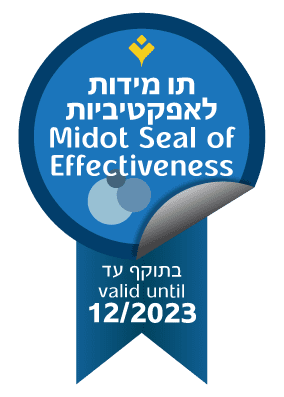The misuse of prescription drugs is a worldwide phenomenon. According to the Israeli Ministry of Health, prescription drug misuse is defined as use that doesn’t abide by a doctor’s instructions, which can cause physical and mental harm (this includes non-medical use for pleasure). Although there are many types of addictive drugs, what the drugs in this section have in common is that they can all be legally obtained with a prescription.
The most frequently abused prescription drugs are opioids, sedatives and sleeping pills (benzodiazepines), and stimulants that are used to treat attention deficit disorders (many of which are based on the active ingredient methylphenidate).
Opioids: Opioid medications are painkillers that are prescribed to those suffering from acute pain. However, the people who use these medications often develop tolerance – that is, the effect of the drug wanes over time, so the dosage must increase in order to compensate. The current research links the observed increase in heroin use in the United States in recent years to the increased consumption of these pain relievers.
Benzodiazepines: These medications include sedatives and sleeping pills that are prescribed to treat anxiety attacks, high stress levels and sleep disorders. These drugs should only be taken for short periods, because long-term use carries the risk of developing tolerance, dependence, and addiction.
Stimulants: These medications are mainly prescribed to those diagnosed with attention deficit disorders (such as ADHD). In the past, these drugs were prescribed to treat asthma, other respiratory problems, and certain neurological disorders, and were used to stimulate weight loss, but over time it became clear that their misuse may cause addiction.
A bit of history
The United States data indicates that since the 1990s, there has been a significant increase in the use of prescription drugs, to the extent that the current phenomenon is considered a pandemic. Surveys show that in the United States alone, tens of millions of people are addicted to prescription drugs, starting from age 12. It is estimated that opioid drugs are the second most popular addictive substance consumed, especially among adolescents. The use of sedatives and sleeping pills (benzodiazepines) is also a growing problem. In the United States it is estimated that approximately 2.3% to 18% of adults use these drugs for non-medical purposes and without a prescription. Over the past two decades, the number of people seeking treatment for addiction or dependence on these drugs has tripled. Since the 1970s, a “black market” has developed for the purchase and sale of stimulant drugs without a prescription, especially among high school and college students. According to various estimates, about 4% of adolescents and young adults use these drugs despite not being diagnosed with a disorder that warrants their use. Nonetheless, they use these medications to boost their ability to concentrate and focus on study materials, especially during exam periods.
Why do people use prescription drugs?
Opioids: Opioids are commonly used to relieve physical pain. However, in many cases, people begin to misuse these drugs as they develop tolerance and as the pain worsens, which leads to cravings for increasingly higher doses. They are also misused when people attempt to treat certain psychiatric disorders, such as depression and anxiety, by self-medicating. Benzodiazepines: In the United States, reports indicate that by 2015 about 38.2 million adults (ages 18 and over) had used benzodiazepine sedatives or sleeping pills at some point — 5.7 million of them had misused them. The most common reasons for benzodiazepine use are the desire to relieve stress, to fall sleep and for pleasure. It is important to emphasize that even those who use these drugs for medical purposes (as sedatives or sleeping pills) are thought to misuse them if they consume higher doses than prescribed or obtain them without a prescription. Stimulants: There are many reasons that people use stimulants without a prescription: for weight loss, to maintain alertness, to increase concentration (especially while studying), and to enhance the effects of other drugs. Abuse of stimulants occurs mainly among people who take the medicine on their own accord, without a doctor’s prescription and without regular follow-up.
What are the adverse health effects of prescription drugs?
Taking a drug in a manner or in a dosage not prescribed by a physician for medical purposes can be harmful in several ways, regardless of whether the drug was taken for therapeutic reasons, such as pain relief, or for another purpose. Over the past 15 years there has been an increase in the misuse of prescription drugs, which has manifested in rising hospital emergency room visits, fatalities, and need for drug rehabilitation. Using prescription drugs without medical supervision can be dangerous and can cause severe side effects due to interactions with other medications or even with dietary supplements (especially common among adults over age 50). What are the risks of opioid abuse? Opioids inhibit pain, but can also cause drowsiness, disorientation, confusion, nausea, constipation, and severe respiratory distress, the last of which is life threatening, especially when taken in combination with alcohol or sedatives. Long-term opioid use may lead to dependence and, in some cases, addiction, which, in turn, can lead to withdrawal symptoms upon discontinuing use. In recent years, there has been an increase in the prevalence of heroin users who began using opioids without a prescription, and then later turned to heroin. In the United States, the high prevalence of opioid use is defined as an epidemic, which takes the lives of about 130 people every day as a result of misuse and overdose. What are the risks of taking benzodiazepines without a prescription? The use of high doses of benzodiazepines can produce serious side effects, including drowsiness, disorientation, confusion, blurred vision, dizziness, weakness, impaired speech and coordination, difficulty breathing, and, in extreme cases, fainting and comas. Prolonged use of benzodiazepines can lead to the development of physical dependence and addiction. As a result, discontinuing use can trigger withdrawal symptoms, which, in extreme cases, can result in dangerous seizures. What are the risks of taking stimulants without a prescription? Stimulant drugs increase alertness, concentration and energy, but can also increase heart rate, breathing and blood pressure. They can induce anxiety symptoms and, in extreme cases, psychosis. Withdrawal symptoms include fatigue, depression, sleep disturbances, hostility, paranoia, and even psychosis. Taking high doses of unprescribed stimulants can induce a life-threatening increase in body temperature, as well as heart arrhythmias and disturbances.
How can I stop abusing prescription drugs?
Prescription drug addiction can be treated effectively. The treatment must, of course, take into account the type of drug used and the needs of the individual. It may be necessary, in some cases, to combine several aspects of treatment – for example, assisting the detoxification process with the use of certain medications, along with treating the underlying problem (that the misused drug was initially taken to address) with other recommended medications. In certain types of addiction, such as opioid addiction, there are specific drugs that help prevent relapse, such as buprenorphine and methadone. In addition to treating addiction with medication, it is also important to include behavioral therapies that modify unhealthy thought patterns and behaviors, in order to help the patient manage the disease and identify situations that can lead to relapse. In addition to rehabilitation programs, it is essential to prevent the misuse of prescription drugs in the first place. This requires policy changes, stricter regulations, better instructions for patients who take prescription drugs, better monitoring and tracing of drug prescriptions, changes in how prescription drugs are consumed, and, last but not least, the development of safer medications.

